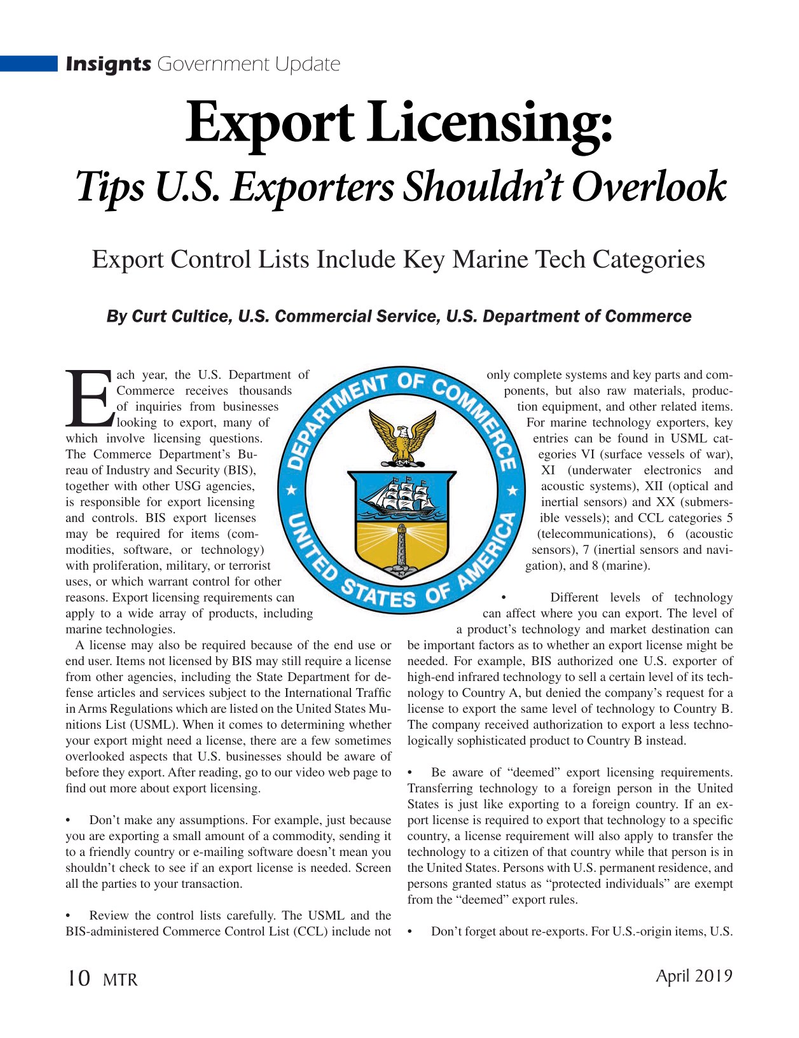
Page 10: of Marine Technology Magazine (April 2019)
Ocean Energy: Oil, Wind & Tidal
Read this page in Pdf, Flash or Html5 edition of April 2019 Marine Technology Magazine
Insignts Government Update
Export Licensing:
Tips U.S. Exporters Shouldn’t Overlook
Export Control Lists Include Key Marine Tech Categories
By Curt Cultice, U.S. Commercial Service, U.S. Department of Commerce ach year, the U.S. Department of only complete systems and key parts and com-
Commerce receives thousands ponents, but also raw materials, produc- of inquiries from businesses tion equipment, and other related items.
E looking to export, many of For marine technology exporters, key which involve licensing questions. entries can be found in USML cat-
The Commerce Department’s Bu- egories VI (surface vessels of war), reau of Industry and Security (BIS), XI (underwater electronics and together with other USG agencies, acoustic systems), XII (optical and is responsible for export licensing inertial sensors) and XX (submers- and controls. BIS export licenses ible vessels); and CCL categories 5 may be required for items (com- (telecommunications), 6 (acoustic modities, software, or technology) sensors), 7 (inertial sensors and navi- with proliferation, military, or terrorist gation), and 8 (marine). uses, or which warrant control for other reasons. Export licensing requirements can • Different levels of technology apply to a wide array of products, including can affect where you can export. The level of marine technologies. a product’s technology and market destination can
A license may also be required because of the end use or be important factors as to whether an export license might be end user. Items not licensed by BIS may still require a license needed. For example, BIS authorized one U.S. exporter of from other agencies, including the State Department for de- high-end infrared technology to sell a certain level of its tech- fense articles and services subject to the International Traf? c nology to Country A, but denied the company’s request for a in Arms Regulations which are listed on the United States Mu- license to export the same level of technology to Country B. nitions List (USML). When it comes to determining whether The company received authorization to export a less techno- your export might need a license, there are a few sometimes logically sophisticated product to Country B instead. overlooked aspects that U.S. businesses should be aware of before they export. After reading, go to our video web page to • Be aware of “deemed” export licensing requirements. ? nd out more about export licensing. Transferring technology to a foreign person in the United
States is just like exporting to a foreign country. If an ex- • Don’t make any assumptions. For example, just because port license is required to export that technology to a speci? c you are exporting a small amount of a commodity, sending it country, a license requirement will also apply to transfer the to a friendly country or e-mailing software doesn’t mean you technology to a citizen of that country while that person is in shouldn’t check to see if an export license is needed. Screen the United States. Persons with U.S. permanent residence, and all the parties to your transaction. persons granted status as “protected individuals” are exempt from the “deemed” export rules.
• Review the control lists carefully. The USML and the
BIS-administered Commerce Control List (CCL) include not • Don’t forget about re-exports. For U.S.-origin items, U.S. April 2019 10
MTR
MTR #3 (1-17).indd 10 4/10/2019 3:55:13 PM

 9
9

 11
11
